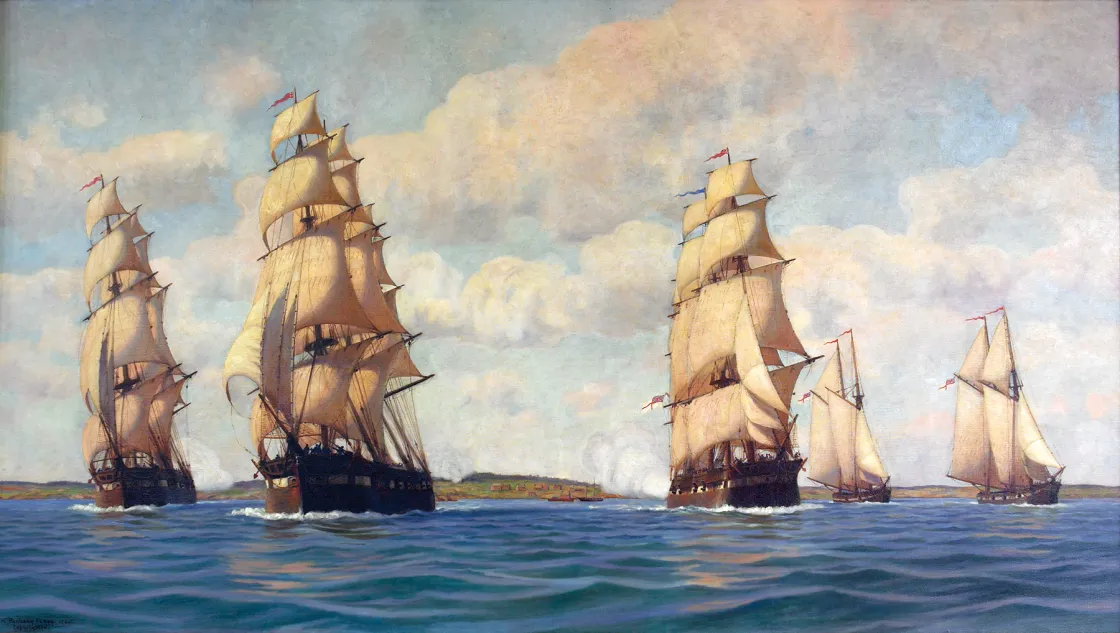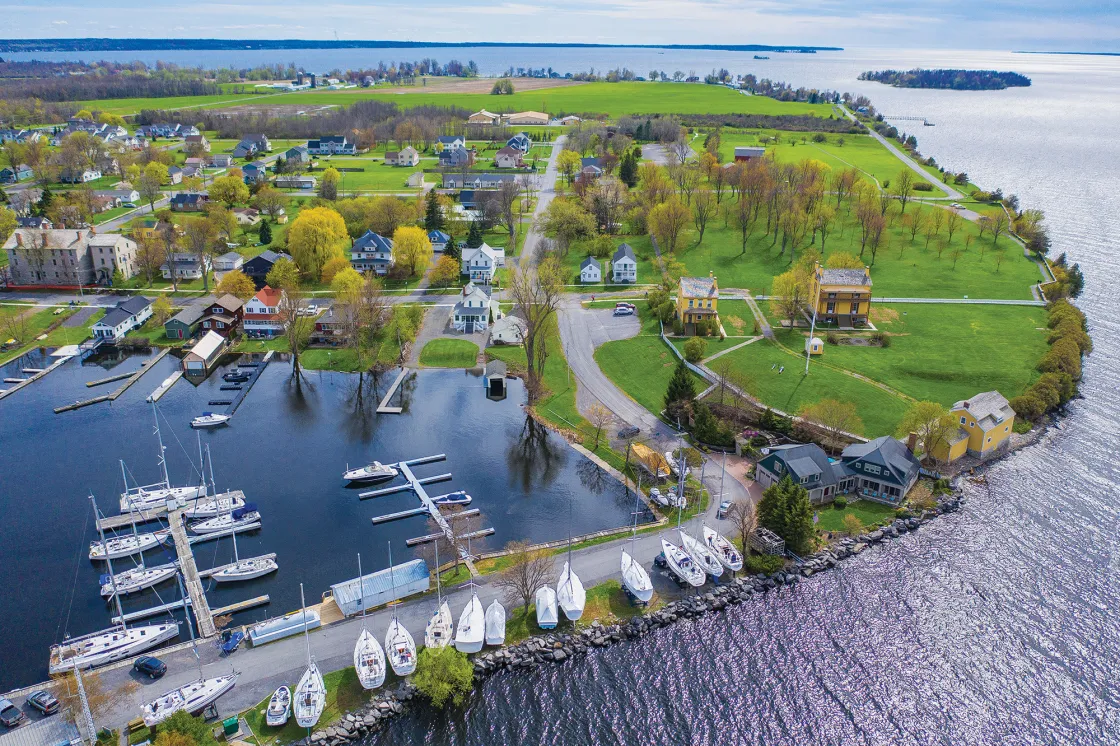Controlling the Waterways at Sackets Harbor

During the War of 1812, the fight for the Great Lakes and the St. Lawrence River culminated at a shipyard on Lake Ontario at Sackets Harbor, N.Y. The British fleet had no idea how feisty the Americans would be.
One year into the conflict known as the War of 1812, both American and British forces were keen to exert control over Lake Ontario and the St. Lawrence River. Doing so would provide a major strategic advantage in the Great Lakes, one of the most hotly contested theaters of war.
American forces on Lake Ontario tried to break the stalemate in the spring of 1813 by attacking the British at York (present-day Toronto), then the capital of Upper Canada. On April 27, 2,700 Americans stormed Fort York, defeating the 750 British and Ojibwa Indians stationed there and forcing their retreat to the military stronghold at Kingston. But the victory came at a high cost and with little strategic benefit, as the Americans were unable to capitalize on their gains.
In retaliation, the British and Canadians embarked on a raid against the American shipbuilding infrastructure at Sackets Harbor, which lay within easy striking distance of the British at Kingston. When the shipyard was left vulnerable — American troops being engaged at the opposite end of the lake in the Niagara region — the British moved to strike.
The attack came in the rainy pre-dawn hours of May 29. Brigadier General Jacob Brown of the New York militia, the senior American officer present, looked to the horizon and realized the “[f]leet approaching was an Enemy, and with a glass we could distinctly see that they had a very liberal supply of Boats – I then no longer doubted but that they were resolved to land with a chosen body of troops and storm our works.”

British troops, personally led by General Sir George Prevost, governor general of Canada, made landfall about a mile west of the village on Horse Island and opposite the island on the mainland shore. Those who landed on the island waded across to the mainland on a submerged natural rocky causeway. The advancing troops were met on the shore by New York militiamen, who were unable to stop the landing party, and rapidly withdrew.
Among the best firsthand descriptions of the battle is that of Balthaser Kramer, written only a few days after the engagement:
“ [W]e Volinteers wass in camp & at 4 OClock in the morning the Battle begun the British had twelve Hundred men ther wass Only One hundred and fifty of Volunteers we Retreated Of the Iand and formd for battle and in a few moments the Cam up to us and we fought them with grate Spirit”
When the fight resumed on the mainland, the assault was met with considerable resistance by the U.S. Regular Troops stationed there. After a three-hour engagement, the invaders retreated heading west to the shore and causeway, and again crossing over Horse Island en route back to their ships.
The Battle of Sackets Harbor had major multinational implications. The Americans successfully defended a strategic shipbuilding facility and military operations headquarters on Lake Ontario. For the British, their failure to seize the command site was a major lost opportunity. Among First Nations and Native American peoples, the engagement demonstrated the complex forces that drove allegiances — two groups are documented as having fought with the British-Canadians, whereas another volunteered to serve with U.S. troops.
Today, the battlefield at Sackets Harbor retains remarkable integrity, for which it was recognized in the 2007 National Park Service Revolutionary War and War of 1812 Historic Preservation Study. Consequently, the New York State Office of Parks, Recreation and Historic Preservation — more commonly known as NY State Parks — purchased 40 battleground acres that same year, expanding the Sackets Harbor Battlefield State Historic Site holdings to 71 acres.

In early 2019, NY State Parks announced it had accepted the transfer of historically significant Horse Island, located just offshore from the village, from the American Battlefield Trust — a project that marked the organization’s first foray into land associated with the War of 1812. Soon, a mainland waterfront plot opposite the island will also become protected through the cooperative efforts of the Trust and NY State Parks. That island’s natural environment remains relatively undisturbed, with little public access during private ownership for the past 62 years.
During that time period, significant advances in understanding of the battlefield were made. Starting in 1967, NY State Parks’s Bureau of Historic Sites laid the basis for professional archaeological studies on-site through seasonal work conducted by Charles Florance, Paul Huey and William Hershey. In time, underwater archaeologists Art Cohn and Kevin Crisman compiled critical knowledge of the community’s role in the war. In recent years, Ben Ford attempted to locate War of 1812 shipwrecks in the bay while exploring Lake Ontario’s maritime cultural landscape. The National Park Service American Battlefield Protection Program funded a 2009 archaeology study of the mainland battlegrounds, conducted by Hartgen Archeological Associates, which provided a wealth of information and helped define the battle’s boundaries.
Such research continues to drive interpretive programming at the state historic site through exhibitions, publications and public programs. Results from any future cultural resources study on Horse Island will merge with information gained by previous explorations, resulting in a much more complete picture of the role the attackers and defenders played during the battle. Furthermore, studying Horse Island may very well yield archaeological deposits related to the earliest human occupation of the eastern Great Lakes Region, adding to the many already documented sites.
Multinational recognition of the battle’s significance came during the War of 1812 Bicentennial, when American, Canadian and British military personnel and civilians annually gathered in three consecutive years to commemorate the engagement. In 2013, the Crown Forces monument memorializing 42 of the opposing force’s soldiers killed during the battle and buried by the Americans was dedicated, and thanks to the combined efforts of American, Canadian and British researchers, more is known about these men. Military staff rides of Sackets Harbor originate from nearby U.S. Army Fort Drum reservation and the Canadian Royal Military College, located just across the lake in Kingston, Ontario.
What is known of the battle comes from historical documentation, plus archaeology conducted on the mainland. Fortunately, there exists many primary historical documents recounting the battle in the form of diaries, notebooks, military logs and published recollections. Archaeologists and historians regularly contribute to the wealth of information gathered on Sackets Harbor’s role in the War of 1812.

Documenting those who passed through this military center during the war years is an ongoing effort. To date, more than 10,000 names are stored in the site’s computer database. These names represent American-born men and immigrants who served at Sackets Harbor, even if only briefly. Recently, members of the Oneida Indian Nation who volunteered with U.S. forces, such as Moses Abram, were documented and added to the 40 already recorded Mohawk and Mississauga of the British-Canadian landing force.
As the participants’ stories emerge from the historical record, these individuals will foster an inspiration for increased appreciation of the Sackets Harbor Battleground, a unique North Country treasure, and hopefully advance stewardship of the whole region’s cultural and natural heritage legacy.
We can save three remarkable battlefield sites if we can raise $201,500. Every dollar you can donate to this cause will be multiplied by $23.80.








